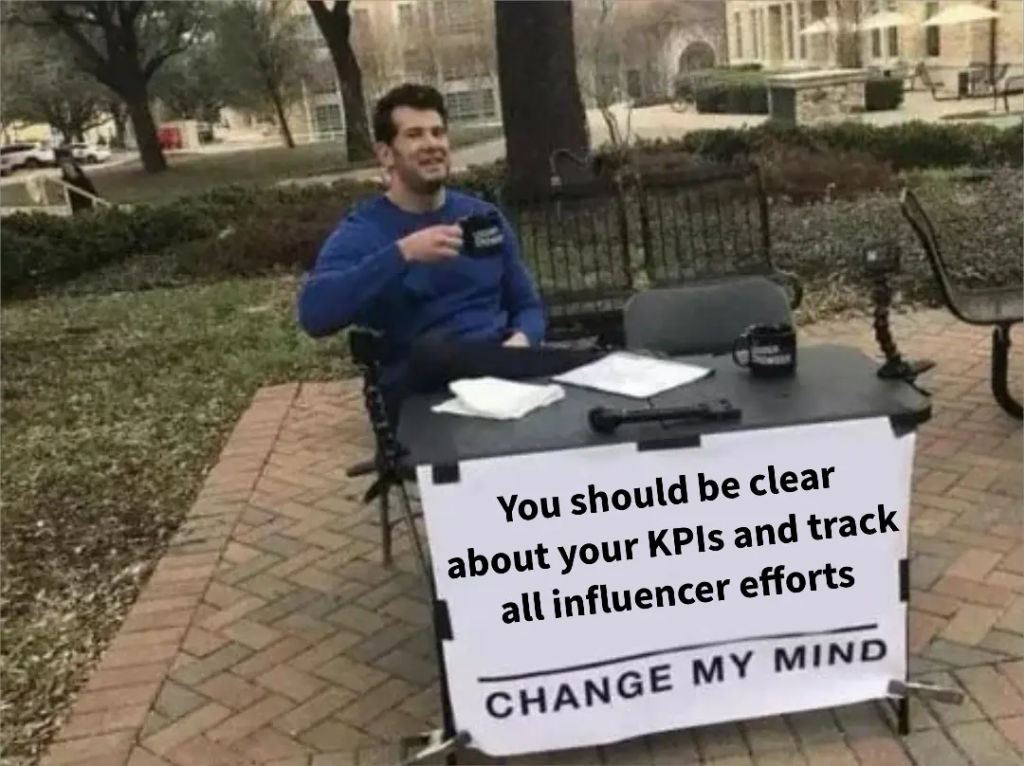Reading Time: 8 minutes
In an era where digital landscapes shift faster than a toddler’s attention span, influencer marketing proves it’s not a fleeting fad but an enduring pillar in the marketer’s toolkit. Gone are the days when brands solely relied on billboard advertisements or TV commercials to reach their audience. Now, with a smartphone in almost every hand, influencers have become the modern-day ambassadors for brands, connecting with audiences on a personal, authentic level. But as this realm of marketing continues to evolve, it prompts the inevitable question: What’s the real return on investment (ROI) in influencer marketing? Is it just a passing trend, or does it truly offer tangible, measurable results? In this analysis, we’ll delve into the hard facts, personal anecdotes, and current statistics to uncover the true power and potential of influencer marketing in 2023.
A Personal Anecdote: Real-world Impact

One doesn’t need to look far to see the tangible results influencer marketing can deliver. Consider our experience with a prominent supplement client as a prime example. After making the strategic shift to influencer-boosted content, the results were nothing short of remarkable. When we started tracking sales driven by this content, we found that it led to purchases at a rate that was 95% cheaper than their previous social ad strategy.
This isn’t just a testament to the efficacy of influencer marketing but also an illustration of its cost-effectiveness. The client didn’t just achieve sales; they achieved them more economically, maximizing their ROI. It’s stories like these that exemplify the transformative potential of influencer marketing. Rather than being lost in the vast sea of digital advertising, brands can leverage trusted voices in the community to resonate deeply with their target audience, driving not just awareness but tangible conversions.
Influencer Marketing in 2023: Key Statistics
The power of influencer marketing isn’t just anecdotal; the numbers speak volumes. 2023 has seen some remarkable trends and insights that validate the increasing trust brands place in influencer marketing. Here’s a breakdown:
- Growth and Valuation: The influencer marketing sector is projected to be worth a whopping $21.1 billion in 2023, up from its $16.4 billion valuation in 2022. This rapid growth underscores the immense faith brands have in its ROI.
- Recognition of ROI: A significant 71% of brands actively measure the ROI of their influencer campaigns. This figure has been on an upward trajectory, with 65% in 2020, 67% in 2021, and 70% in 2022. The consistent rise indicates an increasing acknowledgment of the importance of gauging the financial effectiveness of influencer campaigns.
- Sales Metrics: An impressive 74% of brands now track sales from their influencer campaigns. With sales being a primary metric for influencer marketing ROI, it’s evident that businesses are keen on quantifying the direct impact influencers have on their bottom line.
- Quality Over Quantity: It’s not just about the sales numbers, but also the quality of customers. A notable 82% of respondents believe that customers acquired through influencer marketing are of a higher quality compared to other marketing channels.
- Shift in Metrics: While views, reach, and impressions have taken the lead as the primary metric for success (at 49.6%), conversions and sales remain pivotal for many brands, accounting for 24.9%.
- Earned Media Value (EMV): EMV is emerging as a significant measure of ROI, with 83% of respondents considering it a solid representation. This metric calculates the worth derived from influencer content, giving brands an idea of what an equivalent advertising campaign would cost for the same impact.
The statistics from 2023 paint a clear picture: Influencer marketing is not just a fleeting trend but a cornerstone of modern marketing strategies, delivering substantial ROI for brands willing to invest.
Diving into the ROI Metrics of Influencer Marketing

Understanding the ROI of influencer marketing is crucial for brands looking to invest in this rapidly evolving sector. The influencer marketing trends of 2023 clearly point towards a more metric-driven approach, ensuring every dollar spent is accounted for.
- Setting Clear Campaign Goals: The first step in ensuring a positive influencer ROI is outlining the campaign’s objectives. Whether you’re aiming for brand awareness or immediate conversions, your goals will dictate the influencer marketing metrics you prioritize.
- Brand Awareness Metrics:
- Social Reach: With influencer marketing becoming such a significant trend in 2023, metrics like followers, subscribers, and impressions have taken center stage.
- Engagement: Engagement metrics, which are essential KPIs in influencer marketing, help gauge the depth of the influencer impact on their audience.
- Direct Response Metrics: Tracking influencer marketing results has become more sophisticated. Brands are now keen on:
- Purchases: The ultimate influencer marketing conversion rate metric.
- Signups: Especially critical when measuring the impact influencer marketing has on online platform growth.
- Click-through rate (CTR): An essential influencer metric that evaluates the effectiveness of shared links.
- The Hidden Costs: To understand the true ROI influencer marketing offers, it’s vital to account for all associated costs. This not only includes influencer fees, but also the management involved in running influencer campaigns/programs, and influencer tracking software/tools.
- Evaluating by Channel and Format: Different platforms offer varying ROI. For instance, while YouTube influencer rates may be higher, their impact might also be more profound than other platforms.
- Tools for Tracking: Given the rise of influencer marketing, several influencer tracking tools have emerged. From influencer marketing measurement tools like Google Analytics to more niche platforms like HypeAuditor, they are pivotal in measuring the influencer ROI.
- A Glimpse into Trends and Noteworthy Influencers: Ever wondered, “When did influencers become a thing?” or “Which influencer makes the most money?” These questions highlight the cultural shift and significance of influencers. In 2023, influencers aren’t just social media personalities; they’re brand ambassadors, making influencer tracking and understanding influencer marketing KPIs all the more crucial.
- Why Influencer Marketing Works: Beyond the metrics and KPIs, the real power lies in authenticity. Influencers, especially those in niches like CPG influencer marketing, resonate with audiences on a personal level, making their endorsements far more effective than traditional advertising.
As brands increasingly recognize the potential impact influencer marketing offers, it’s essential to have a comprehensive understanding of the costs, KPIs, and metrics. This ensures a positive ROI and helps brands harness the full potential of influencer collaborations in 2023 and beyond.
2023 Influencer Marketing Industry Trends
The 2023 statistics provided by Influencer Marketing Hub shed light on the evolving intricacies of influencer marketing:
- Tracking Sales and ROI: A significant 74% of brands now actively track sales from influencer campaigns. This growing emphasis on direct ROI demonstrates the evolving maturity of influencer marketing strategies.
- Attracting Sales Through Influencers: Referral links and email addresses remain primary methods for tracking influencer-generated sales. Advanced tools are becoming increasingly popular to offer more granular data insights.
- Quality Over Quantity: A noteworthy 82% of brands believe that customers acquired through influencer marketing are of higher quality than those from other channels. This aligns with our experiences at Markerly, where we’ve consistently seen the value of quality engagements in influencer campaigns.
- Evolution of ROI Measurement: The industry has seen a steady uptick in brands measuring their influencer marketing ROI, reaching 71% in 2023.
- Earned Media Value (EMV): EMV is emerging as a pivotal influencer marketing KPI, highlighting the broader recognition of the multifaceted value influencers bring to brands.
- Platform-Specific Insights: Platforms like TikTok are at the forefront of influencer marketing, showcasing immense potential for ROI. We’ve seen firsthand at Markerly the benefits of crafting strategies tailored to specific platforms.
- Performance-Based Compensation: The move towards tying influencer compensation to performance underscores the industry’s commitment to tangible, measurable results.
The 2023 data emphasizes the data-driven and ROI-focused trajectory of influencer marketing. As the landscape continues its rapid evolution, at Markerly, we remain dedicated to harnessing these trends for the benefit of our partners.
Recent Influencer Marketing Trends and Their Implications
Statistics from 2023 highlight how brands are adapting and evolving their strategies to harness the full potential of influencer collaborations.

- Sales Tracking and Its Growing Importance: The fact that 74% of brands are now tracking sales from influencer campaigns speaks volumes. It highlights the industry’s movement towards a more tangible and results-driven approach.
- Methods to Drive and Track Sales: The various methods brands employ, from email addresses to referral links, demonstrate the diverse strategies in play. The use of unique identifiers like coupon codes further emphasizes the precision brands are aiming for in their influencer ROI calculations.
- Perceived Value of Influencer-Generated Leads: The belief that influencer marketing attracts higher quality customers (82% of respondents) underscores the unique value proposition of influencers. It’s not just about numbers, but the quality of engagement and leads.
- Shift in Success Metrics: The transition from primarily focusing on conversions/sales to views/reach/impressions indicates a broader understanding of influencer impact. It’s not just immediate sales, but the overall brand presence and awareness that influencers can amplify.
- Emergence of Earned Media Value (EMV): With 83% of respondents seeing EMV as a good representation of ROI, it’s clear that brands are beginning to appreciate the long-term and indirect value influencers bring to the table.
- Budgetary Commitments: The increased allocation of budgets towards influencer marketing, with 67% intending to raise their influencer marketing budget in 2023, is a testament to the positive ROI experiences of brands.
- Platform Dynamics: The data suggests a shifting landscape, with platforms like TikTok rising in prominence. Adapting to these shifts is crucial for brands to stay relevant and maximize their influencer marketing ROI.
- Changing Compensation Structures: The trend towards performance-based compensation aligns with the industry’s move towards tangible, measurable results, further emphasizing the data-driven nature of influencer marketing in 2023.
The Growth and Future of Influencer Marketing
The increasing investment that brands are making in influencer marketing is not a mere trend—it’s a testament to its efficacy and the evolving digital landscape. Here’s a snapshot of the projected growth and what it suggests about the future:
- Monetary Growth of the Industry: With influencer marketing projected to be worth $21.1 billion in 2023, up from $16.4 billion in 2022, there’s clear evidence of its growing appeal and effectiveness. This substantial jump indicates a robust ROI, attracting more brands to invest in influencer partnerships.
- Belief in Its Effectiveness: The slight dip in the percentage of respondents who believe in the effectiveness of influencer marketing, from 90% to 83%, may raise eyebrows. However, this can be attributed to the maturation of the industry—brands are becoming more discerning, and with greater investment comes increased scrutiny.
- Budgetary Allocations: The data indicates a positive sentiment towards influencer marketing. 82% of respondents plan to allocate a budget to influencer campaigns in 2023, up from the previous year. This reflects the confidence brands have in the ROI of influencer marketing.
- Intention to Increase Spend: The fact that 67% of respondents plan to increase their influencer marketing budget in 2023 further underscores the positive experiences and returns brands have observed from their influencer campaigns.
- Platform Dynamics: TikTok’s emergence as a leader for short-form video ROI, preferred by 42% of respondents, indicates the shifting preferences and the importance of staying updated with platform-specific influencer marketing trends.
- Shift in Payment Structures: The move towards compensating influencers based on a percentage of sales value (53% of brands adopting this) is indicative of a broader industry trend. Brands are keen on tying costs directly to results, further emphasizing the ROI-driven approach in influencer marketing.
- Affiliate-Influencer Hybrid Approach: The trend of compensating influencers akin to affiliate marketing models suggests that brands are keen on tangible returns. It merges the best of both worlds, ensuring influencers are rewarded for the direct impact they create.
The growth trajectory and evolving trends in influencer marketing point towards an industry that’s becoming more ROI-focused, sophisticated, and integral to brands’ overall marketing strategies. As we navigate these changes at Markerly, we remain dedicated to providing our partners with cutting-edge strategies that harness the full potential of influencer marketing.
Embracing the Power of Influencer Marketing
Influencer marketing has never been more dynamic. As the data from 2023 indicates, brands are not only increasing their investments in this space but are doing so with a heightened focus on measurable outcomes. Whether it’s tracking direct sales, amplifying brand awareness, or leveraging the unique value proposition of influencers, the shift towards a more data-driven approach is evident.
Yet, while numbers and metrics are vital, the essence of influencer marketing lies in genuine connections. Influencers, with their authentic voices and dedicated communities, offer brands a unique avenue to connect with audiences in meaningful ways. This blend of authenticity with measurable ROI is what makes influencer marketing a potent tool in the modern marketer’s arsenal.
At Markerly, as we reflect on these evolving trends and insights, our commitment remains unwavering: to guide our partners through the intricacies of influencer marketing, ensuring they harness its full potential. Whether you’re a brand just dipping your toes into the influencer world or looking to optimize your existing campaigns, the future is ripe with opportunities. Embrace the power of influencer marketing, and let’s craft stories that resonate, engage, and drive results.

